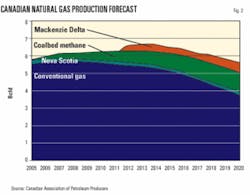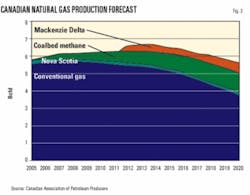Unconventional gas, Arctic gas, and offshore gas developments hold the greatest promise for reversing Canada’s struggling natural gas production outlook.
And liquefied natural gas imports will add to the nation’s gas supply mix.
Canada is the No. 3 gas producer in the world, yet it produces over 6 tcf/year-of which more than half is exported to the US-against reserves that have been steadily declining for years. Canada’s reserves of conventional gas, estimated by OGJ at 56.577 tcf as of Jan. 1, 2006, fell slightly from the year before despite a record pace of drilling. And that number is unchanged from what the Canadian Association of Petroleum Producers (CAPP) reported as of Dec. 31, 2003. It also marks a decline in gas reserves in Canada of about 13% since 1996. Petroleum Technology Alliance Canada (PTAC), a nonprofit association supporting oil and gas research in Canada, estimates that the country’s conventional natural gas reserve life index has fallen below 9 years.
Yet there are some slight signs of improvement. CAPP estimates the number of gas wells to be drilled in Canada this year at 17,700, almost double the level of 2002. Canadian gas production increased slightly in 2005 to 17.3 bcfd-and up from 16.1 bcfd in 2003. CAPP notes that the country’s gas output in the first quarter of 2006 is up 700 MMcfd from the same period in 2005, spurred by the spike in North American gas prices.
Gas producers’ dilemmas
Canadian gas producers’ chief dilemma is the diminishing volumes of gas coming from new wells. In short, they are working harder than ever to replace their reserves.
According to a study conducted for CAPP, the average reserves booked for each natural gas well completion has dropped to 0.4 bcf from 1 bcf 6 years ago. The upshot: 2.5 times as many wells must be drilled to yield the same volume of reserves as was the case in the 1990s.
At the same time, gas finding and development costs have been soaring in the past decade-and especially since 2002, with the tightness in service and supply markets. Canadian gas F&D costs averaged $3 (Canadian)/Mcf in 2005.
In short, the more than 60,000 producing wells in the Western Canada Sedimentary Basin are playing out, and getting more production out of this traditional mainstay region is becoming more difficult and costly.
With all the hurdles, Canada’s independent producers remain focused on gas. Talisman Energy Inc. has 90% of its investment program in North America aimed at natural gas.
The rationale, according to Ron Eckhardt, executive vice-president, North American operations, is simple: “The Western Canada Sedimentary Basin is predominantly gas-prone. We have likely seen peak conventional oil production, unless there are significant new offshore discoveries.”
For Talisman, “Increasing costs, long lead delivery times for major items, and a shortage of skilled people are significant issues,” Eckhardt says. “Talisman has mitigated these issues through strategic alliances with suppliers, stockpiling long lead-time items, bulk buying, and long-term contracts for rigs. We continue to attract and retain high-quality people, hiring 200 people in North America last year.”
Unconventional gas
Increasingly, Canadian gas producers are targeting unconventional gas. Coalbed methane (CBM) in particular is a recent success story. PTAC, in the early part of the decade, spearheaded technology transfer efforts and conferences that helped lay the groundwork for much of the CBM drilling under way in Canada today.
Commercial production of CBM jumped to more than 250 MMcfd in 2005 from almost nothing before 2003. CAPP estimates CBM output today at 500 MMcfd and predicts that volume will climb to about 1.5 bcfd by 2010.
That’s just the tip of the iceberg for unconventional gas in Canada. PTAC estimates Canada’s unconventional natural gas reserves at more than 700 tcf for tight sands, more than 860 tcf for tight shales, and more than 700 tcf for CBM.
Technology advances in enhanced recovery represent another growth opportunity for Canadian natural gas. PTAC sees Canada’s 147 tcf of conventional gas in place as a target to apply new technology to boost recovery rates to as much as 72% from an average 59%.
Other supply
Offshore Canada has recently opened up as a contributor to Canada’s gas production profile. The Sable Offshore Energy Project, operated by Shell Canada Ltd. and Imperial Oil Ltd. off Nova Scotia, started production in 1999. It produces over 500 MMcfd from several fields.
Plans also are under consideration for developing the combined 4 tcf of gas reserves in the Hibernia and White Rose oil field developments off Newfoundland. And significant gas discoveries have been made off Labrador: 4.6 tcf of marketable gas and 123 million bbl of natural gas liquids, more than half of which is in Bjarni field off Goose Bay.
Canada’s Arctic has hosted major gas discoveries for decades. The Mackenzie Delta, in the Northwest Territories, holds 9-10 tcf of identified reserves. CAPP estimates northern Canada holds 77 tcf of marketable gas. The key to marketing that gas, however, is the much-disputed Mackenzie gas pipeline proposal, which seems likely to miss its original target date of a 2006 construction onset and 2010 start-up.
The $7 billion (Canadian), 760-mile, 1.2 bcfd pipeline would ship Mackenzie Delta gas to Alberta’s existing gas grid, along with a parallel pipeline to carry NGLs.
While Canadian gas accounts for 85% of US gas imports, Canada nonetheless is looking overseas to help it offset a growing shortfall of domestic supply. At least three LNG receiving terminals have been proposed in eastern Canada, representing a total potential supply of 4 bcfd of capacity by 2008.
“Talisman has 90% of its investment program in North America aimed at natural gas. The Western Canada Sedimentary Basin is predominantly gas-prone. We have likely seen peak conventional oil production, unless there are significant new offshore discoveries.” -Ron Eckhardt, executive vice-president, North American operations, Talisman Energy Inc.


